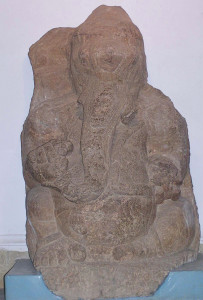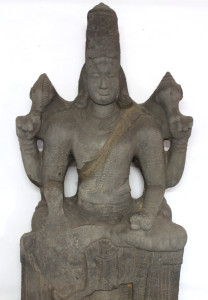Registered with the Registrar of Newspapers for India under R.N.I 53640/91
Vol. XXVIII No. 15, November 16-30, 2018
Our Museum’s wealth
- by Chithra Madhavan
Of Pallava and Chalukya sculpture
 Ganesa, Eastern Chalukya dynasty.
Ganesa, Eastern Chalukya dynasty. Vishnu, Pallava era.
Vishnu, Pallava era.Among the numerous monuments and sculptures found in various parts of Tamil Nadu, those belonging to the Pallava dynasty are perhaps the best known to those living in Chennai. This is because of the close proximity to the major centres of Pallava power such as Kancheepuram and Mamallapuram, apart from several less-known locations. The stone sculpture gallery of the Government Museum, Chennai, has a fairly good collection of carvings from this era, the most eye-catching being a large image of Vishnu.
Seated with His left leg on a tall pedestal and the other resting on the ground, Vishnu’s tall, somewhat cylindrical crown is typical of the Pallava times. Vishnu, as is normally seen, holds the discus (chakra) in the upper right hand and the conch (sankha) in the upper left hand. However, the chakra seen here, as in many other sculptures of Vishnu from Pallava times, is not in the usual position with the flat side facing the onlooker; instead, the rim of the discus pointing outward. The technical term for this position is prayoga or “in use” as Vishnu is said to be ready to hurl the chakra at enemies.
Another interesting sculpture from the Pallava section of this gallery is one which is described in the plaque accompanying it as a “horned dvarapalaka” from Kaveripakkam. Obviously this doorkeeper (dvarapalaka) once guarded an ancient temple in Kaveripakkam. Though the name sounds as though this very historic place is located somewhere near River Kaveri, it is in fact in Vellore District, about 30 km from Kancheepuram. This image of the “horned dvarapalaka” is badly damaged, with only the upper part of the body still intact. He is in a slanting pose because he originally would have been leaning on his heavy stone mace. Having a fierce expression on his face, with bulging eyes and protruding teeth, the horns on his head are perhaps the feature that most visitors would see first and wonder why they are there. Art historians have identified dvarapalakas with such “horns” as the personification of Nandi, the guardian of Siva’s abode, but there are others who say that the two pointed “horns” with a central sharp spike seen in some of the dvarapalakas would represent the trident (trishula) of Siva.
In the Pallava gallery is also seen a graceful figure of a worshipper kneeling with a flower in his hand; Dakshinamurti (Siva as the bestower of wisdom) in a yoga pose, also from Kaveripakkam; a wornout sculpture of Durga as Mahishasura Mardini and others.
Directly opposite the Pallava section are sculptures from the era of the Eastern Chalukyas. It is indeed unfortunate that most school and college students are unaware of this important dynasty which ruled in the Andhra area. Their contemporaries, the Western Chalukyas who ruled from ancient Vatapi (present-day Badami in Karnataka), are better known. It was in the reign of the eminent Chalukyan king Pulakesin II in the 7th Century C.E. that one of his brothers, Khubja Vishnu Vardhana, was a viceroy in the Satara area and later in Vengi (covering the Godavari and Krishna Districts in Andhra Pradesh). He later went on to establish the Eastern Chalukyan dynasty which lasted till approximately the first half of the 12th Century C.E. The art of this time resembles that of the Western Chalukyas. The sculptures in this section of the Madras Museum are from various places ruled by the Eastern Chalukyas and mostly belong to the 7th Century C.E. The most prominent one, displayed right in the middle, is a large sandstone Ganesha. Seen with a long trunk holding a bowl of this deity’s favourite sweet, modaka, and wearing a serpent as a girdle, this sculpture is much weather-worn.
Next to Ganesha is a Nataraja from a place called Biccavolu, now in East Godavari District. Stylistically different from those seen in the Tamil land of the same period, this Nataraja is seen with the matted hair (jata), third eye on the forehead (trinetra), two different earrings (kundala), and a trident with a long handle in the right hand. The other attributes of this much damaged figure are not clear. Also from Biccavolu, is a sculpture of Siva with a back slab and Nandi standing behind. Again badly broken, this carving of Siva standing absolutely straight, has the lower right hand in the gesture of blessing (abhaya hasta). The upper left hand holds a snake and the lower left hand hangs down with the palm close to the horns of Nandi. Even in its damaged state, it is a splendid piece of art.
These two sections, Pallava and Eastern Chalukya, situated opposite each other in the stone sculpture gallery go to show the regional variations in art in South India, though these dynasties were contemporaries for about a couple of centuries.

